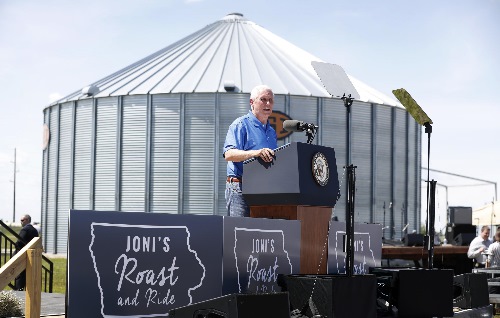There’s no state that will serve as a better bellwether of the political environment this year than Iowa, a mostly rural, racially homogenous state featuring plenty of close congressional races. If President Trump loses further ground in the suburbs but maintains support with his white working-class base, Republicans should fare well in the Hawkeye State and maybe even pick up a House seat or two. But if the GOP’s collapse is all-encompassing, Trump is in danger of losing a political stronghold, and Democrats would be well-positioned to win a majority-making Senate seat.
Polls show Iowa is as up for grabs as ever. President Trump won the state by 9 points in 2016, but a new Monmouth poll shows his lead has shrunk to just 3 points. The same poll showed Sen. Joni Ernst leading her Democratic opponent, Theresa Greenfield, by 2 points. Three of the state’s four House races are genuine battlegrounds, currently held by Democrats; the Monmouth survey found Democrats leading in two and Republicans leading in one. But both parties’ internal polling shows all three races highly competitive and could tip in either direction.
BREAKING: 1 Cup of This Melts Belly and Arm Fat (Take Before Bed)
The state serves as a reminder that there are still persuadable voters in politics, at a time of rampant political polarization. Iowa features the largest proportion of Obama-Trump voters in the country, comfortably supporting Trump in 2016 after backing Barack Obama by a double-digit margin in the 2008 election. The midterms offered a split decision: Gov. Kim Reynolds won a hard-fought election, but Democrats picked up two House seats in hotly contested campaigns.
It’s not a coincidence that the Trump campaign has been keenly focused on winning Iowa. Vice President Mike Pence is paying particular attention to Iowa, making his third trip to the state during the pandemic next week. Trump visited the state in June to promote ethanol production.
But while the presidential race is taking center stage, it’s the downballot races that will tell more of the political story for 2020. If Trump doesn’t carry Iowa, it’s almost impossible to envision how he wins the presidency. And even if he prevails, Democrats still have plenty of pathways to 270 electoral votes. At the presidential level, the state will simply show whether Trump managed to maintain support with the prairie populists that fueled his initial victory.
In the battle for the Senate, however, there’s no bigger contest in the country. If Ernst manages to win a second term, Republicans have a credible shot at salvaging their majority—or at least holding Democrats to 50 Senate seats (making Sen. Joe Manchin, no friend to liberals, a powerbroker). It would underscore the persistent demographic crosscurrents in the electorate, where college-educated suburbanites have moved into the Democratic column while blue-collar Midwestern voters keep Republicans afloat.
But if Greenfield prevails, it would suggest that Democrats have cracked the working-class code to expand their coalition. Greenfield, an earnest but inexperienced candidate, is far from the highest-profile challenger that Senate Democrats recruited. If she succeeds, it would be a sign that Democrats have a shot at winning a red-state battleground like Montana, where popular Gov. Steve Bullock is their standard-bearer. Put those states on the board for Democrats, and the Senate majority expands to the point where the party would be able to pass consequential legislation.
The state’s House battlegrounds, all of which Trump carried in 2016, are equally intriguing. Republicans view TV anchor-turned-state legislator Ashley Hinson as one of their top recruits, running against freshman Rep. Abby Finkenauer in eastern Iowa’s 1st District. But while Trump carried the working-class district by 3 points in 2016—after Obama carried it by 14 points four years earlier—Republican and Democratic strategists agree that he’s lost his edge since then. Finkenauer was an early and enthusiastic Joe Biden booster; if he wins the district, she’s well-positioned to prevail. (The Monmouth poll showed Finkenauer leading, 51 to 41 percent.)
The 2nd District is an open-seat race to replace retiring Democratic Rep. Dave Loebsack. The district is a mix of small farm towns alongside the urban population center of Davenport and Iowa City, home to the University of Iowa. State Sen. Mariannette Miller-Meeks, running for the fourth time, led Democratic 2018 lieutenant governor nominee Rita Hart by 3 points in the Monmouth survey. But Democrats believe that as Hart parlays her fundraising advantage, she’ll be able to erase any early deficit.
TRENDING: Newly Legalized Herb Relieves Pain - Available Without A Prescription
The 3rd District is the most suburban in the state, covering Des Moines and its suburbs while also including the beef-grazing territory of southwest Iowa to the Nebraska border. The race is a rematch from 2018, pitting freshman Rep. Cindy Axne against former Rep. David Young. A July internal poll for Young’s campaign showed the former congressman leading Axne by 1 point, an encouraging sign given the rough political environment for Republicans. But if the suburban part of the district swings away from Republicans, it will be challenging for Young to overcome.
All of these races hinge on the national environment. If Trump manages to win the state, it’s an encouraging sign for downballot Republicans during a time of minimal split-ticket voting. But if Biden adds Iowa to the list of states that he flips, it would suggest a big blue wave wiped out the GOP’s chances of maintaining power in Washington.








